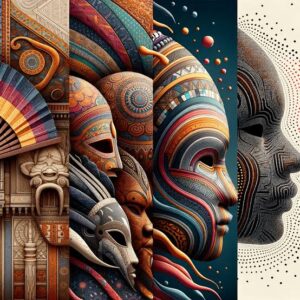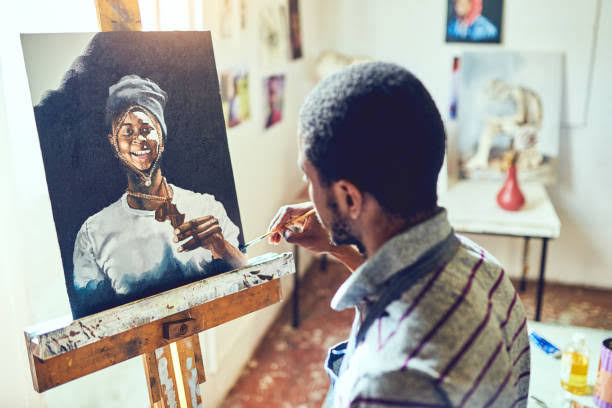African art is a treasure trove of history, culture, and innovation that has left a lasting impact on global design. With origins dating back thousands of years, African art is rich in symbolism and storytelling. From intricate masks and sculptures to textiles and jewelry, the influence of African aesthetics has found its way into fashion, interior design, contemporary art, and even architecture across the globe. In this article, we delve into the origins and evolution of African art and explore how its distinct elements continue to shape and inspire artists and designers worldwide.
The Origins of African Art: A Historical Perspective
African art dates back to prehistoric times, with rock carvings and paintings in places like Algeria’s Tassili n’Ajjer or South Africa’s Drakensberg Mountains. As African civilizations evolved, so did their art, incorporating materials like bronze, ivory, wood, and beads to represent stories, social values, and religious beliefs. Art forms varied across regions, from the elaborate bronze castings of the Benin Kingdom to the symbolic geometric patterns of the Ndebele people in Southern Africa.
Key Characteristics of African Art:
– Symbolism and Spirituality: African art is deeply rooted in spirituality, with many pieces serving as representations of deities, ancestors, or mythological tales.
– Geometric Patterns and Abstraction: African art often utilizes bold, repetitive patterns and abstract designs, influencing Western avant-garde art movements.
– Connection to Nature: Animal figures and natural materials are commonly used, showcasing the deep connection African cultures have with the environment.

These characteristics have intrigued artists and designers around the world, driving African art’s influence beyond its native continent.
African Art’s Influence on Western Modernism
African art made a groundbreaking impact on Western art movements in the early 20th century, particularly on Cubism and Surrealism. Artists like Pablo Picasso and Henri Matisse drew inspiration from African masks, sculptures, and textiles. Picasso’s iconic Les Demoiselles d’Avignon is often cited as a result of his fascination with African masks, characterized by bold lines and simplified forms. African art’s abstraction and emphasis on geometric shapes also inspired Constructivism and Abstract Expressionism.
Today, African art continues to shape the world of fine art, from influencing European museums to inspiring contemporary artists. Its distinct features and powerful symbolism remain relevant, with a growing appreciation for African art’s cultural significance rather than simply its aesthetic qualities.
African Art in Fashion: Prints, Patterns, and Heritage
African prints and textiles have left an unmistakable mark on global fashion. Kente cloth, mud cloth, and Ankara prints have become iconic, with designers across continents adopting these fabrics and patterns in runway shows, streetwear, and haute couture. Designers like Stella Jean, Ozwald Boateng, and Maki Oh have incorporated African-inspired designs into their collections, celebrating African heritage while appealing to global audiences.
In addition to fabrics, African jewelry, beadwork, and accessories have also influenced fashion. Traditional Maasai beadwork, Tuareg silver jewelry, and bold, layered necklaces reminiscent of Zulu adornments have inspired jewelry designers worldwide, adding a touch of African elegance and culture to their creations.
Interior Design: Bringing African Art Into the Home
African art’s influence in interior design has led to a rise in Afrocentric decor, where traditional African patterns, textures, and colors are used to create warm, earthy, and cultural spaces. Key African art elements commonly featured in global interior design include:
– African Masks and Sculptures: These symbolic artifacts have become popular decor items, representing African spirituality and culture.
– Textiles and Weaving: African fabrics such as mud cloth and kuba cloth add texture, color, and depth to home decor.
– Earthy Color Palette: African art often features warm, natural colors, like burnt orange, ochre, and brown, making homes feel cozy and connected to nature.
Top interior designers around the world are increasingly looking to African art for inspiration, blending traditional African elements with modern decor to create spaces that feel timeless and grounded.
Architecture and African Art
The influence of African art extends to architecture as well. Vernacular African architecture, which emphasizes harmony with the environment, sustainable materials, and functional aesthetics, has inspired architects globally. For instance, thatched roofing, clay structures, and open layouts are finding their way into contemporary designs, especially in eco-friendly or minimalist architectural styles.
The Great Mosque of Djenné in Mali, with its mud-brick architecture and intricate wooden detailing, has inspired sustainable design in modern architecture, proving African architectural art to be timelessly influential.
Contemporary African Artists on the Global Stage
Today, contemporary African artists continue to push boundaries and make an impact on the international art scene. Artists like El Anatsui, known for his large-scale installations made from recycled materials, and Njideka Akunyili Crosby, celebrated for her vibrant collages that merge African and Western influences, have brought African perspectives to the forefront of global art.
The rise of African art fairs and exhibitions, such as 1-54 Contemporary African Art Fair and ART X Lagos, underscores the world’s growing interest in African contemporary art. These platforms have been instrumental in showcasing the depth and diversity of African art, allowing artists to tell their stories and make their mark on the global stage.
The Future of African Art and Design
As global interest in African art continues to grow, there is a significant push toward acknowledging the cultural and historical context behind these designs. For African artists and designers, this era represents an opportunity to showcase their heritage, address stereotypes, and redefine the narrative surrounding African art.
Beyond influencing visual aesthetics, African art is reshaping conversations around identity, culture, and heritage. From fashion to architecture, African art continues to inspire and enrich the global design landscape, proving that its impact is far-reaching and enduring.
Conclusion
African art has transcended its origins, becoming a significant influence in the worlds of fashion, fine art, interior design, and architecture. As it continues to shape global trends, African art is more than a source of inspiration; it is a powerful storyteller of culture, resilience, and innovation. As more people around the world embrace African aesthetics, they become part of a growing movement to celebrate and honor the beauty and depth of African heritage. The future of art and design is undeniably enriched by the legacy of African artistry, and this influence will undoubtedly continue to shape creative industries for generations to come.




